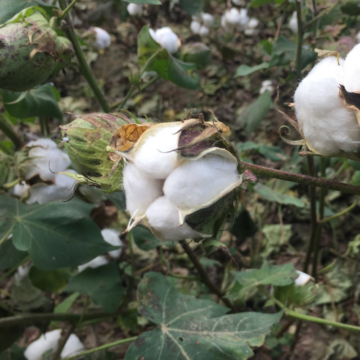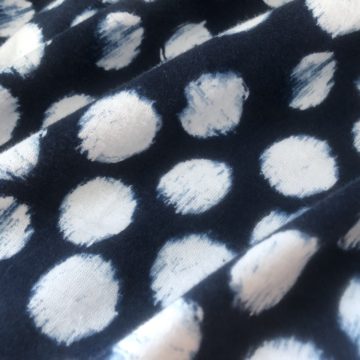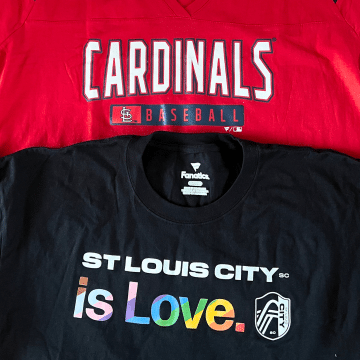
One of the most interesting parts of having such a clear niche in blogging is having people contact me about specific things they want to know about cotton. While some of those questions are about jobs or things I really can’t solve, I love helping diagnose problems. You may have seen the post about why a cotton boll was so tiny a few years ago. The recent conversation about planting container cotton plants though, really made me stretch my mind muscles beyond just the whether cotton can be grown in a backyard garden!
Email About Container Cotton I Received
The email I received asking me a deep question follows. Please note, I’m not including the name, etc cause I’m not sure that would be cool with them. However, I did say I wrote them such a long reply I thought I may turn it into a post.
Hello Janice, I live in central North Carolina. Last year my girlfriend and I picked two plants from a farmers field nearby and put them in potting soil black plastic pots at out respective homes for decoration. After winter I pulled 16 seeds from my one boll and planted them in the same pot next to other flowers. This spring – NOTHING grew. I mean NOTHING. No clover, no weed grass – just bare soil. It is so barren it looks like the soil was poisoned. Pots next to it were alive with weeds and spontaneously generate new plants even after hand weeding. Same soil, same care (none), same feeding (none). Is this cotton a Monsanto GMO plant with ‘Roundup’ springing forth from its corps?
Thanks. BTW: The farmers field has NO volunteer weeds among the cotton.
Reading that, you can tell, the person writing it was perplexed. There are a lot of things I wanted to know as I read it because I think we both came at it with really different backgrounds and ideas. Over the years, I’ve found if I can ask people several questions, I probably can give them a better answer.
Questions I Asked & Answers I Received
Really, I enjoy getting messages from real people who have read something here & decided to share or ask questions. (I’m not a fan of the robo requests for placing a post here.) Here’s what I sent back:
I’ll be glad to help think through what may have happened. I have some questions that will let me be sure I understand.
— When you say you picked a cotton plant, did you just cut the stalk and put the stalk in a pot or did you dig up the roots?
— When you picked the plant, was the cotton boll you collected seed from already open or was it a green boll that cracked open later? Any chance you have photos?
— Was the plant/seed kept inside your home over winter or left outside?
— The pot you had the cotton plant in…. you said it was in potting soil. Have you used the soil for other things before or was it fresh from the bag.This may make a good blog post. And where in NC are you? I have family in the Asheville & Charlotte areas. Love the state.
I have to admit, I wasn’t sure I’d get a reply, but I did. One-by-one, all my questions got answered:
1. We neither cut the stalk nor dug it up – we pulled up the plants by the trunk including the roots. They were runt plants at the edge of the field by the road.
2. Yes the cotton was open and the cotton boll showing nicely.
3. Both the plants overwintered alongside the driveways with the other potted plants – which always come back in the spring.
4. Yes the potting soil was previously used for flowers such as sweet william or hemp plants.
I went out this morning to look again – still the soil in that pot is bare – but in pots to the left and right are rich with grasses / weeds – greenery on either side of the pots that the cotton was in.
Very mysterious. Where are YOU Janice? Want to come see?
My Response Got Really Long
It was obviously mysterious, but I had a lot of information that I thought could help. As I started my reply, it really was going long. I have to confess, I thought hard about ways to simplify it. Make it shorter. Easier to read. I did the best I could but it was still long. I share it here in case you are following and have questions:
Thanks for the offer of a visit but I’m in the middle of the country… not in NC often unless I have a detailed agenda with family. I am sure you understand that doesn’t leave time for random cotton plant checks 🙂 There is a state cotton specialist in Raleigh if you want to talk to someone local. https://www.ces.ncsu.edu/profile/guy-collins/
I am trying to figure out what some of the issues are and there are really a couple of big possibilties:
1) The seed wasn’t mature so it wouldn’t germinate. There are a few things that can happen to plants during the growing season — maybe the plants didn’t get enough heat units during the period when the seed was forming, maybe moisture in the fall led the seeds to rot, etc. In fact, because that is so likely, each state and seed companies have testing facilities that pull samples of commercial seed and test it. And the plants that help bag seed also frequently use various screening processes to determine whether the seed is the right color or weight, etc. There is also a question of whether the seed went through dormancy which is the way the seed’s energy moves from harvest to gain the energy needed to sprout in the spring. This post explains some of the problems.
2) Planting conditions may have been challenging. Cotton is a somewhat fussy plant. Potting soil can really retain water and cotton seedlings want just a bit of water. They typically do better in sandier soils than potting soils are. You also want to think about the depth the seed was planted. Cotton likes a good bit of space — farmers usually plant a couple of seed every 6 inches. It also likes a specific set of temperatures to emerge so you want to make sure the soil is 65 degrees or so, 6-9 inches deep. More on planting.
I’d bet one of those two things is the reason the seed didn’t emerge. The other question you raised was about why nothing else is growing in the pot. That’s a real puzzle for me too. The one idea you mentioned was whether that could be related to the seed. I’ve never heard of anything with cotton seed having an impact on other things growing. In fact, cotton farmers build full weed control programs using cover crops, etc to protect young cotton plants from the weeds and grasses that grow up with them. This post will help you understand some of that.
The way you asked the question about Roundup, I can tell you have heard about GMO crops. You may not be familiar with the way they work. The Roundup Ready cotton you mention is popular in North Carolina so the seed may have carried the trait. The way that trait works, a single gene was found in aquatic environments that made Roundup or glyphosate was ineffective on it so some of Monsanto’s scientists was added to a cotton plant. I’ve met a bunch of those folks working at the company. The trait allows farmers to spray Roundup on the cotton when weeds and grasses are growing all around and while the vast majority of weeds will be controlled, the cotton (or soybeans) will grow successfully. Farmers usually focus on controlling weeds and grasses early in the season, when plants are small because as they grow, the plants shade out any new plants from growing.
Understanding all of that, I wonder whether the difference is whether the other plants (all perennials) had attracted pollinators to play on them. That may have accounted for some of the extra things ending up in the same soil.
I will keep giving this thought. One of the things I wonder is how much of the root structure was there. Cotton’s tap root is usually 3 foot or so on a healthy plant and I’m guessing pulling this was a lot shorter. So that may have impacted the seed’s viability.
Definitely feel like I wrote a full blog post writing this whole thing out so I am going to see about turning it around.
Hope this helps!
And I forgot to remind him about the boll weevil eradication program being a challenge!
Where We Are Now
So, that was a lot to take in. And I’m still thinking about some of the causes — now that I have this all in a blog post, I can get some expert opinions on it too!
My new friend admited I overloaded them a bit. They also decided to do a few things to see what else they can figure out. They will:
- Send a soil sample to the state department of agriculture to be tested.
- See if some other plants will grow in that pot/soil.




